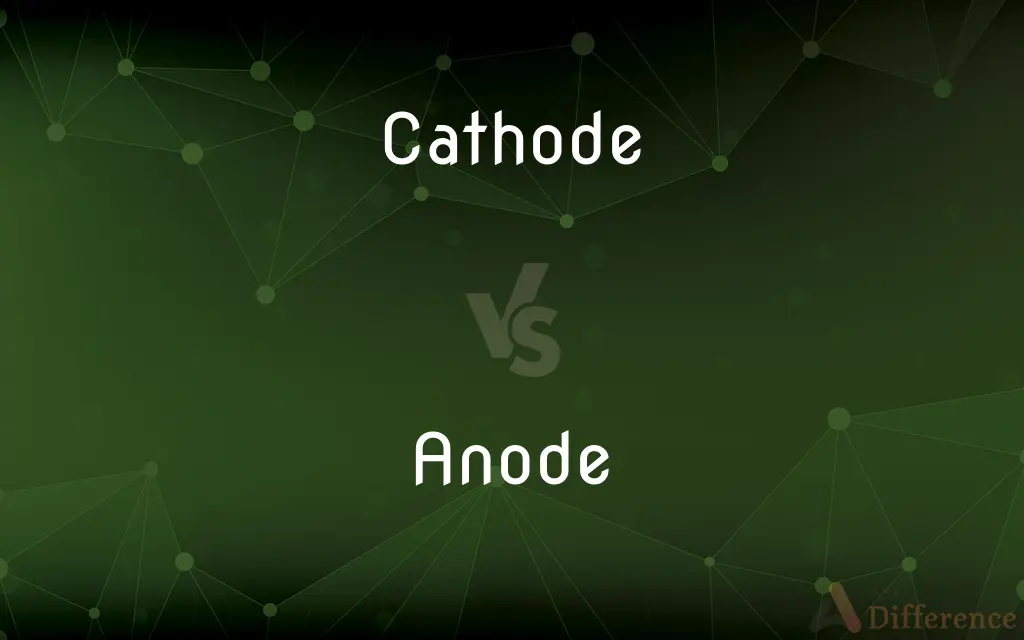Cathode vs. Anode — What's the Difference?
By Tayyaba Rehman & Maham Liaqat — Updated on March 29, 2024
A cathode attracts cations (positive ions) and undergoes reduction, whereas an anode attracts anions (negative ions) and is the site of oxidation.

Difference Between Cathode and Anode
Table of Contents
ADVERTISEMENT
Key Differences
A cathode is a type of electrode in an electrical circuit through which electrons move outwards, resulting in the reduction (gain of electrons) of the chemical species. Whereas, an anode is an electrode through which electrons enter, leading to the oxidation (loss of electrons) of the chemical species. This fundamental difference highlights the roles each plays in electrochemical reactions, where the cathode acts as the electron receiver and the anode as the donor.
In a rechargeable battery, the cathode becomes the positive terminal during the discharging process, as it attracts cations from the electrolyte. On the other hand, the anode becomes the negative terminal, attracting anions towards it. This role reversal is crucial in devices like lithium-ion batteries, where the flow of ions between the electrodes enables charging and discharging.
During the electrolysis process, the cathode is connected to the negative terminal of the power source, which makes it the site where reduction reactions occur, receiving electrons from the power source. Conversely, the anode is connected to the positive terminal, where oxidation reactions take place, donating electrons to the power source. This differentiation is essential for the decomposition of compounds.
In a galvanic or voltaic cell, the cathode is the positive electrode, indicating its role in driving the spontaneous chemical reaction forward by gaining electrons. Meanwhile, the anode is the negative electrode, supplying the electrons that are lost in the reaction. This distinction is critical in the production of electrical energy from chemical reactions.
The materials used for cathodes and anodes differ based on their function. Cathodes are typically made from materials like nickel, manganese, and cobalt, which have a high affinity for electrons. Anodes, however, are made from materials such as zinc, lithium, or graphite, which readily give up electrons. This material choice is pivotal for the efficiency and capacity of batteries and electrochemical cells.
ADVERTISEMENT
Comparison Chart
Electrical Charge (in circuit)
Negative in rechargeable batteries when discharging
Positive in rechargeable batteries when discharging
Reaction Type
Reduction (gains electrons)
Oxidation (loses electrons)
Connection in Electrolysis
Negative terminal of power source
Positive terminal of power source
Role in Galvanic Cell
Positive electrode, attracts cations
Negative electrode, attracts anions
Common Materials
Nickel, manganese, cobalt
Zinc, lithium, graphite
Compare with Definitions
Cathode
The positive terminal in a rechargeable battery during discharge.
The lithium ions move towards the cathode during discharge.
Anode
Connected to the positive terminal in electrolysis.
The anode loses electrons to the power source, facilitating oxidation.
Cathode
An electrode where reduction occurs.
In a battery, the cathode receives electrons from the external circuit.
Anode
Attracts anions in an electrochemical cell.
Chloride ions migrate towards the anode in the electrolysis of saltwater.
Cathode
Connected to the negative terminal in electrolysis.
The cathode gains electrons to reduce copper ions to copper metal.
Anode
An electrode where oxidation occurs.
At the anode, water molecules lose electrons to form oxygen gas.
Cathode
Attracts cations in an electrochemical cell.
Sodium ions migrate towards the cathode in a molten salt electrolysis.
Anode
The negative terminal in a rechargeable battery during discharge.
Lithium moves from the anode to the cathode when a lithium-ion battery discharges.
Cathode
Made from materials that have a high affinity for electrons.
Cobalt oxide is often used as a cathode material in lithium-ion batteries.
Anode
Made from materials that readily give up electrons.
Graphite anodes are popular in alkaline batteries for their conductivity and oxidation potential.
Cathode
A cathode is the electrode from which a conventional current leaves a polarized electrical device. This definition can be recalled by using the mnemonic CCD for Cathode Current Departs.
Anode
An anode is an electrode through which the conventional current enters into a polarized electrical device. This contrasts with a cathode, an electrode through which conventional current leaves an electrical device.
Cathode
A negatively charged electrode, as of an electrolytic cell, storage battery, diode, or electron tube.
Anode
A positively charged electrode, as of an electrolytic cell, storage battery, diode, or electron tube.
Cathode
The positively charged terminal of a primary cell or a storage battery that is supplying current.
Anode
The negatively charged terminal of a primary cell or of a storage battery that is supplying current.
Cathode
(electricity) An electrode, of a cell or other electrically polarized device, through which a positive current of electricity flows outwards (and thus, electrons flow inwards). It usually, but not always, has a positive voltage.
Anode
(electricity) An electrode, of a cell or other electrically polarized device, through which a positive current of electricity flows inwards (and thus, electrons flow outwards). It can have either a negative or a positive voltage.
Cathode
The electrode at which chemical reduction of cations takes place, usually resulting in the deposition of metal onto the electrode.
Anode
The electrode at which chemical oxidation of anions takes place, usually resulting in the erosion of metal from the electrode.
Cathode
(electronics) The electrode from which electrons are emitted into a vacuum tube or gas-filled tube.
Anode
(electronics) The electrode which collects electrons emitted by the cathode in a vacuum tube or gas-filled tube.
Cathode
(electronics) That electrode of a semiconductor device which is connected to the n-type material of a p-n junction.
Anode
(electronics) That electrode of a semiconductor device which is connected to the p-type material of a p-n junction.
Cathode
The part of a voltaic battery by which the electric current leaves substances through which it passes, or the surface at which the electric current passes out of the electrolyte; the negative pole; - opposed to anode.
Anode
The positive pole of an electric battery, or more strictly the electrode by which the current enters the electrolyte on its way to the other pole; - opposed to cathode.
Cathode
A negatively charged electrode that is the source of electrons in an electrical device
Anode
A positively charged electrode by which electrons leave an electrical device
Cathode
The positively charged terminal of a voltaic cell or storage battery that supplies current
Anode
The negatively charged terminal of a voltaic cell or storage battery that supplies current
Common Curiosities
What is a cathode?
A cathode is an electrode where reduction occurs, attracting cations and gaining electrons.
How do cathodes and anodes function in a battery?
In a battery, the cathode attracts cations and undergoes reduction during discharge, while the anode attracts anions and undergoes oxidation.
What is an anode?
An anode is an electrode where oxidation occurs, attracting anions and losing electrons.
Can the roles of cathodes and anodes change?
Yes, the roles of cathodes and anodes can reverse in rechargeable batteries during the charging process.
What happens at the cathode during electrolysis?
During electrolysis, the cathode is connected to the negative terminal and reduction reactions occur, gaining electrons.
How do cathodes and anodes work in a galvanic cell?
In a galvanic cell, the cathode is the positive electrode that attracts cations, while the anode is the negative electrode that attracts anions.
What materials are used for anodes?
Anodes are typically made from materials such as zinc, lithium, or graphite.
What is reduction?
Reduction is a chemical reaction involving the gain of electrons, typically occurring at the cathode.
What materials are used for cathodes?
Cathodes are often made from materials like nickel, manganese, and cobalt.
What is oxidation?
Oxidation is a chemical reaction involving the loss of electrons, typically occurring at the anode.
What happens at the anode during electrolysis?
During electrolysis, the anode is connected to the positive terminal and oxidation reactions occur, losing electrons.
What is the charge of a cathode in a discharging battery?
In a discharging rechargeable battery, the cathode is the positive terminal.
What is the charge of an anode in a discharging battery?
In a discharging rechargeable battery, the anode is the negative terminal.
How do the roles of cathodes and anodes differ in electrolysis and battery operations?
In electrolysis, cathodes and anodes are connected to the power source's negative and positive terminals, respectively, whereas in batteries, they attract opposite ions and undergo opposite reactions (reduction at cathode, oxidation at anode) during discharge.
Why are different materials used for cathodes and anodes?
Different materials are used for cathodes and anodes due to their respective electron affinity and donation capabilities, affecting efficiency and capacity.
Share Your Discovery

Previous Comparison
Dominance vs. Epistasis
Next Comparison
Rude vs. PoliteAuthor Spotlight
Written by
Tayyaba RehmanTayyaba Rehman is a distinguished writer, currently serving as a primary contributor to askdifference.com. As a researcher in semantics and etymology, Tayyaba's passion for the complexity of languages and their distinctions has found a perfect home on the platform. Tayyaba delves into the intricacies of language, distinguishing between commonly confused words and phrases, thereby providing clarity for readers worldwide.
Co-written by
Maham Liaqat













































